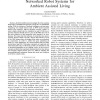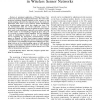SUTC
2010
IEEE
14 years 4 months ago
2010
IEEE
—Robotic middlewares increasingly allow the seamless integration of multiple heterogeneous robots into one distributed system. With the inclusion of ambient intelligence and perv...
SUTC
2010
IEEE
14 years 4 months ago
2010
IEEE
—To date many activity spotting approaches are static: once the system is trained and deployed it does not change anymore. There are substantial shortcomings of this approach, sp...
SUTC
2010
IEEE
14 years 4 months ago
2010
IEEE
Because radio waves decay rapidly in sea water, acoustic communication is the most popular choic for underwater sensor networks. However, since the propagation speed of acoustic w...
SUTC
2010
IEEE
14 years 4 months ago
2010
IEEE
Abstract—A prominent application of Wireless Sensor Networks is the monitoring of physical phenomena. The value of the monitored attributes naturally depends on the accuracy of t...
SUTC
2010
IEEE
14 years 4 months ago
2010
IEEE
—A primary functionality of wireless sensor networks (WSNs) is transporting the information acquired by the sensors as per the desired application requirements. The diverse appli...
SUTC
2010
IEEE
14 years 4 months ago
2010
IEEE
—We present a novel information theoretic approach to make network coding based storage secure against pollution attacks in sensor networks. The approach is based on a new decodi...
SUTC
2010
IEEE
14 years 4 months ago
2010
IEEE
—In distributed sensor networks, computational and energy resources are in general limited. Therefore, an intelligent selection of sensors for measurements is of great importance...
SUTC
2010
IEEE
14 years 4 months ago
2010
IEEE
—To maximize the communication throughput for wireless sensing systems, designers have attempted various combinations of protocol design and manual code optimization. Although th...
SUTC
2010
IEEE
14 years 4 months ago
2010
IEEE
— Extensive research has been performed to study selfish data caching in ad hoc networks using game-theoretic analysis. However, due to the caching problem’s theoretical root ...



